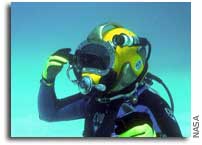NEEMO 11 Topside Support: Mission Day 2: Sunday, September 17th, 2006

Mission: September, 2006 Saturation
Today at about 10:21 am Sandy Magnus, T.J. Creamer, Tim Kopra, Bob Behnken, and Larry Ward joined an elite group of people in this world who have spent 24 hours under the sea in “saturation”, making them the world’s 5 newest aquanauts. Roger Garcia, of course, was already an experienced aquanaut. Sandy, by virtue of having flown in space and lived under the sea, becomes the 14th “aquastronaut”! NASA is in the early phases of designing the space suit for Lunar and Mars exploration, and the NEEMO Project is deep in the heart of the solution, in conjunction with astronaut Mike Gernhardt and the Advanced Projects Office. The Apollo moon walks demonstrated that the weight and center of gravity (c.g) of the space suit and portable life support system backpack were important parameters affecting astronaut performance. To investigate the acceptable c.g. limits for future designs, the NASA EVA Physiology, Systems and Performance Project (EPSP) working in conjunction with the Crew and Thermal Systems engineers have developed reconfigurable c.g back pack that can be worn by divers on “sea walks”. On Sunday the NEEMO divers weighed out at lunar gravity levels (1/6 g), donned the reconfigurable backpacks and performed a series of tasks representative of planetary exploration. These tasks, performed under six different center of gravity configurations included: timed walks, jogs and runs, kneeling, falling and recovering, picking up rocks, shoveling and climbing ladders. The divers evaluated each of the tasks using a modified Cooper-Harper rating scale. The timed ambulation tasks will be compared to a control group performing the same ambulations using a partial gravity weight relief system at the Johnson Space Center. This comparison will allow the data to be adjusted for the effects of water drag.
The advantages of performing these tasks on saturation excursion dives include a real operational environment, unlimited time duration and the ability to investigate the full six degree of freedom work volume. For safety reasons the ground based partial gravity simulators do not allow subjects to fall down. They will also wear the reconfigurable c.g backpacks while performing other mission tasks. The divers will perform half of the task with the c.g currently planned for the Lunar/Mars suit and the other half with the c.g configuration that had the best Cooper-Harper ratings. This data will be combined with c.g studies in other environments (partial gravity simulator and parabolic flight) to drive out the optimum configuration of the exploration suit portable life support system (backpack). This is the 3rd NEEMO mission collecting subjective data on best c.g. configurations.
The Superlite 17 is a hard hat diving system, and is one of the most popular commercial diving systems in the world. For “surface” exploration tasks, it allows our aquanauts to be weighted to give a buoyancy effect like the gravity on the moon and Mars, and gives them a limited visibility helmet much like they might find in a space suit. For simplicity and safety reasons, it uses an umbilical instead of a closed-loop life support system.
Note the helmet camera on top. During these excursions, you can see what they see and hear the live communications between our aquanaut team and the Mission Control team in Houston via streaming video at the NURC website below: http://www.uncw.edu/aquarius/thumb_cam.htm
Scroll down to the “Diver Cam” section, and choose which diver you want to follow along with. It requires “Quicktime” to be installed, but will prompt you through the installation if your computer doesn’t already have it loaded.
Finally, the crew and Houston-based control team got a chance to do some piloting exercises with the underea robot we call “Scuttle”. Scuttle can be a surface rover, or a free flyer (resembling the end of a robotic arm.) It can be controlled by the control center in Houston, or the in situ crew. As the mission continues, as with NEEMO 9 and 10 before it, we will be experimenting with all options and documenting lessons learned to help answer the larger question of how best to split work between the ground-based control team and crew. Over the course of multiple missions we expect to have a significant database to help drive our lunar ops concepts.








